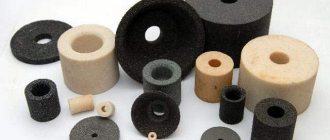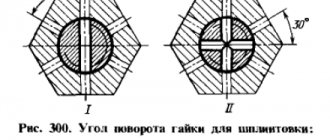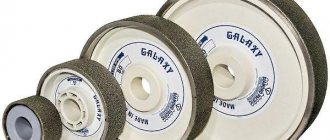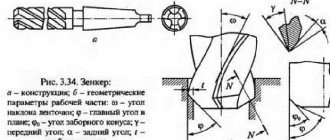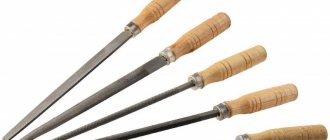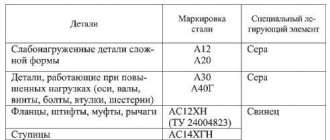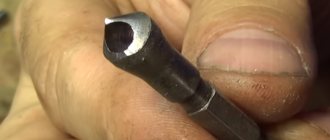Purpose of grinding wheels
The grinding tool is designed to remove the surface layer of material in order to give the part the specified geometric dimensions or the required surface roughness. In addition, a straight grinding disc is used for grinding castings, cleaning welds, and removing scale, rust and other contaminants from the surface of metal products. Various shapes of grinding wheels allow for mechanical processing and grinding of not only straight, but also curved surfaces. In this case, the abrasive tool can act as a template for the profile of the surface being processed. Fine grinding is performed to give the surface of the product the required cleanliness class. To do this, use polishing discs with very fine grains and a soft bond. Another area of use for grinding wheels is sharpening various tools: carpentry, metalworking and metal-cutting tools used on machine tools.
A separate category consists of grinding wheels with a shank, designed for use with hand-held power tools with chucks.
Types of grinding wheels
There are various classifications of types of grinding wheels based on their technical characteristics: by shape, by brand of abrasive, by type of bond, by grain size. The combination of such parameters determines the type of processing for which a particular abrasive disc can be used. According to their production purpose, they are divided into grinding (for coarse and fine grinding) and stripping (grinding). The former are used for all types of grinding and sharpening, and the latter are used for cleaning metal surfaces from various contaminants.
One of the most common subtypes of grinding wheels, which has its own name, is emery wheels used in electric sharpeners.
Grinding
Abrasive discs used for machining, sharpening, grinding and polishing are collectively called grinding discs. Basically, they are used to remove irregularities and reduce surface roughness on products made of mineral materials and various metals. There are a large number of shapes and sizes of such tools, most of which are intended for grinding work on metal. In addition to the most common straight profile grinding wheels, which are commonly used for sharpening tools and working on flat surfaces, there are many other types of specially shaped ones. For example, disc wheels are used for processing the teeth of cutters and cutters, conical wheels are used for grinding threads, and cups are used for face grinding. There are also grinding wheels for polishing work on flat and profile surfaces.
Roughing
One type of rotary grinding tool is a grinding wheel. By this name you can understand that they are used for cleaning surfaces before the main machining or welding operations. These grinding wheels have a straight profile (type according to GOST No. 1), and therefore another name for such a tool is a cleaning disk. They are used for processing castings and welds, as well as for removing burrs, rust and old paintwork. If a stripping disc is used to remove crusts and scale from cast blanks and forgings, then it is called a stripping disc. During operation, grinding wheels are subjected to strong impacts, so bakelite mixtures are used as a binder.
LABELING, PACKAGING, TRANSPORTATION AND STORAGE
5.1. On the body of a circle with an outer diameter of 225 mm or more the following must be clearly marked: the trademark of the manufacturer; type, dimensions of the circle according to GOST 17123; CBN grade; grain; degree of hardness of ceramic bonded wheels, sound index (for A8 type wheels with a diameter of 1 to 22 mm); brand of bond (for ceramic bond wheels it is marked - K or K27, for organic bond wheels - O or PC); working speed of circles (except 35 m/s); relative concentration of elbor (relative concentration 100 is not marked); batch number (or circle number); standard designation; image of the state Quality Mark for the circles to which it was assigned in the prescribed manner. For export, the inscription “Made in USSR” is applied; the standard designation and the manufacturer’s trademark are not applied.
5.2. The body of a wheel with an outer diameter from 50 to 225 mm is marked with: grain size; degree of hardness; relative concentration (relative concentration 100 is not marked); CBN grade; working speed.
5.1, 5.2. (Changed edition, Amendment No. 1 and 2).
5.3. Marking of circles with a diameter of less than 50 mm is applied on a label affixed to the box with circles, with information according to clause 5.1.
5.4. The wheel markings must be clear and remain until the wheel is completely worn out.
5.5. Each circle must be wrapped in KOH grade I paper according to GOST 1908 or other packaging materials that protect the CBN-containing layer from damage. Circles with a diameter of less than 125 mm must be tightly packed in cardboard boxes in accordance with GOST 9421 or GOST 7376. Circles with a diameter of 125 mm or more - in cases or boxes made of cardboard grade T in accordance with GOST 7376. It is allowed to pack circles directly into boxes to ensure their safety. To prevent the circles from moving around, cotton wool and foam rubber should be used in the box. Packing two or more lots in one box is not allowed.
For export, boxes with circles must be tightly packed in boxes in accordance with GOST 24634, the bottom of which must be lined with a layer of dry sawdust, shavings or other packaging material. When packing circles sent to countries with a tropical climate, the inner walls of the boxes must be lined with paper in accordance with GOST 18277, GOST 2228, GOST 10127, GOST 8273. Bags of silica gel must be placed in the boxes. The boxes must be tied with twine in accordance with GOST 17308. The free ends of the twine must be sealed with a wax seal. (Changed edition, Amendment No. 1).
5.6. Each batch of wheels must be accompanied by a quality document. If one batch of circles is packaged in several boxes, a quality document is included in each of them, which indicates: the trademark of the manufacturer; type and dimensions of the circle according to GOST 17123; CBN content in carats; batch number; number of circles in the batch; date of manufacture; technical control stamp; designation of the standard. For export, the standard designation and the manufacturer's trademark are not applied.
5.7. Cases (boxes) with circles must be tightly packed in wooden boxes in accordance with GOST 5959 or other containers that ensure the safety of the circles during transportation.
5.8. Other requirements for labeling and packaging, as well as transportation and storage - in accordance with GOST 27595. (Changed edition, Amendment No. 3).
5.9-5.13. (Excluded, Amendment No. 3). Section 6. (Deleted, Amendment No. 2).
Designations of grinding wheels according to GOST
The main characteristics of grinding wheels are its shape, geometric dimensions, types of abrasive and binder material, hardness and speed parameters. When marking abrasive wheels, various manufacturers rely on both old and new editions of GOST, but in general it contains the same information with minor differences, which mainly relate to the designations of grain size and hardness. Technical parameters of grinding wheels can be applied to the outer surface of the disk either in the form of one line or in separate information blocks.
Read also: Melting point of copper table
The one-line marking of the grinding wheel shown below looks like this: 125x20x32 63C 40 K-LV 35 m/s GOST 52781-2007. If everything is clear with the size and speed in this line, then the remaining parameters require decoding. 63C means the grinding wheel is made of green silicon carbide, 40 is the grit code, KL is the hardness type, V is the ceramic bond. Although the full format of the GOST marking line includes ten fields: [Type] [Dimensions] [Abrasive grade] [Grit size] [Hardness] [Structure] [Bonding] [Linear speed] [Accuracy class] [Unbalance class] [Normative document] , – designations of some characteristics in the marking of real products may be omitted.
Circle shape
GOST 52781-2007 describes grinding wheels of twenty-four forms, each of which is assigned a name and a digital code indicated in the first field of the marking. For example, the most popular straight profile grinding wheel has the code “1”, and the conical cup, which is commonly called “grinding cup”, has the code “11”. In addition to them, the GOST list contains many forms with various darts and profiled working surfaces, among which the most common are disc grinding wheels.
Size
The same GOST provides tables with standard dimensions for each shape of grinding wheels, which are indicated in the second field of the marking line. For a straight profile grinding wheel, a size range of thirty diameters is established in the range from 6 to 1250 mm, with each diameter corresponding to a certain set of mounting hole values and thicknesses. Profile grinding wheels have much fewer diameter options: from four to ten.
Type of abrasive
The third field of the grinding wheel marking contains the code of the brand of abrasive used in its manufacture. The most common among them are electrocorundum and silicon carbide. Depending on the percentage of aluminum oxide, electrocorundum is divided into white (grade designation - from 22A to 25A) and normal (12A÷16A). In addition, there are several varieties of it with the addition of chromium, zirconium and titanium oxides, which are used in special-purpose grinding wheels. Two types of silicon carbide are used as abrasives: black and green. The first varieties are designated by letters from 52C to 55C, and the second - from 62C to 64C.
Silicon carbide is harder than electrocorundum, but is more fragile, less heat-resistant and is less well retained by the bonding material of the grinding wheel.
Grain
The grain size value is indicated in the fourth field of the marking. This parameter determines the class of surface cleanliness after it has been processed with a grinding wheel: the smaller the abrasive grain size, the lower its roughness. But fine grain does not allow large allowances to be removed, which reduces grinding productivity. This parameter must be selected in accordance with the type of processing: for roughing, use grinding wheels with coarse grains, and for grinding and sharpening, use grinding wheels with fine grains.
Different GOSTs and for different materials use different systems for designating the grain size of grinding wheels. In the example above, the designation according to GOST 3647-80 is used, according to which the grain size code must be multiplied by ten, resulting in the approximate grain size in microns. “Approximate” - because according to the GOST table, the number 40 corresponds to an interval of 400–500 microns. GOST R 52381-2005 uses the international designation of grain size, which consists of the letter F and a number. This encoding is subject to the following rule: the larger the number in the designation, the smaller the grain size. For example, at F 10 the grain size is 2085 µm, and at F 100 it is 129 µm.
Hardness
The fifth field for marking grinding wheels is assigned to the hardness code. In this case, we are not talking about the abrasive, but about the hardness of the grinding wheel, which largely depends on the type and quality of the binding material. This parameter directly affects the ability of the grinding wheel to self-sharpen during material processing, i.e., to be cleaned of damaged and dull abrasive particles and thus restore its cutting surface. In accordance with GOST R 52587-2006, eight types of hardness are established, each of which is assigned several Latin letters to indicate the range of hardness within a particular type. The first type is called “very soft” and is designated by the letters F and G, and the latter is “extremely hard” (letters V to Z). In our example, the grinding wheel is designated KL and is classified as medium-soft.
Structure
The sixth field of the marking line indicates the code of the grinding wheel structure. In this case, the word “structure” means the ratio of the volume of abrasive particles to the total volume of the product. This parameter is characterized by the concept of “density”: the more grains per unit volume, the higher the density of the structure, and the more abrasive its composition. The density of the structure has 12 gradations, divided into four groups: from “dense” (1÷4) to “highly porous” (11 and 12). Our grinding wheel does not have this parameter in the marking, but on the top of the label it is written: “for electric sharpeners.” Therefore, it most likely has an average structure (5÷7).
Type of bundle
Grinding wheels retain their shape and performance thanks to binding materials (ligaments), which ensure operation at specified speeds and retain abrasive grains in their volume. There are only three main types of such bonds, and their codes are indicated in the seventh field of the grinding wheel marking. Ceramic consists of a mixture of traditional inorganic substances (quartz sand, clay, feldspar, etc.), which are sintered into a hard and heat-resistant, but rather fragile composite. This type of bond is designated by the letter V. Bakelite bond is made from bakelite, a hard and durable thermoset, and is designated by the letter B. These are the two most common types of binders used in the manufacture of grinding wheels. The third bond, which is used much less frequently, is based on vulcanized synthetic rubber, which is why it is called “vulcanite” (denoted by the letter R). In the picture below, there is bakelite in the center, and ceramic grinding wheels on the edges.
Rotational speed
The eighth field of the marking line indicates the maximum value of the peripheral speed (i.e., the maximum cutting speed). In our case it is equal to 35 m/s. Cutting speed is one of the main parameters of any cutting tool, and it is easily converted into revolutions per minute. However, most manufacturers also indicate the maximum rotation speed on their grinding wheels in addition to the peripheral speed.
Read also: Valtec welding machine for polypropylene pipes
Accuracy class
The accuracy classes of grinding wheels regulate the permissible deviations of all three geometric dimensions, tolerances for eccentricity and non-parallelism, the possibility of the presence and size of defects, as well as the size and density of foreign inclusions. There are three accuracy classes in total, which are indicated in the ninth position of the marking. The first is designated by the letters AA and refers to grinding wheels intended for high-precision processing. According to the other two (A and B), general-purpose tools are made.
Unbalance class
The last parameter, the code of which completes the marking line, is the unbalance class of the grinding wheel, which indicates the uniformity of mass distribution over the volume. Its value depends on the quality of preparation and processing of the mixture of binder and abrasive, as well as on the geometric accuracy of the wheel. In total, there are four classes of imbalance, which are designated in the labeling by numbers from 1 to 4.
CONTROL AND TEST METHODS
4.1. The size of circles is controlled using universal or special measuring instruments. The error of the measuring instruments used must ensure the necessary measurement accuracy in accordance with GOST 8.051.
4.2. The presence of cracks on the working surface and body of the wheel is checked visually. The size of shells and chips is controlled at a magnification of 10.
4.3. Radial, axial runout and runout in a given direction are determined on the mandrel with an indicator. The radial runout of the mandrel and the axial runout of the base end of the mandrel must not exceed the 4th degree of accuracy according to GOST 24643. The diameter of the base end of the mandrel must comply with GOST 2270. It is allowed to use other measurement methods, including non-contact ones, according to methods approved in the prescribed manner.
4.4. Measuring the hardness of the CBN-containing layer of circles using the ball indentation method is a mandatory application.
4.5. Control of sound indices - according to GOST 25961.
4.6. Control of unbalance of ceramic bonded wheels with a diameter of 250 mm or more - in accordance with GOST 3060.
4.7. Testing of wheels for mechanical strength - according to GOST 12.3.028. Section 4. (Changed edition, Amendment No. 2).
The role of ligaments
Unlike rubber, felt, wire and fiber grinding wheels for grinders and other driven tools, abrasive wheels are monolithic products that operate at high speeds and experience significant centrifugal, impact and temperature loads. And if abrasive grains play the main role in ensuring the quality and productivity of grinding, then the mechanical characteristics, heat resistance and self-sharpening ability are provided by binding materials.
There are no ideal connections with universal parameters. Ceramic ones have sufficient rigidity, good wear resistance, and are resistant to high temperatures and chemicals. But they are quite fragile, and therefore very sensitive to bending loads and impacts. Bakelite is quite elastic and self-sharpenes well. But due to the characteristics of the binding material, they are less wear-resistant and cannot work at high temperatures. Partial improvement in the quality of binding materials is achieved through the use of special additives.
ACCEPTANCE RULES
3.1. To verify compliance of the wheels with the requirements of this standard, acceptance inspection and periodic testing are carried out.
3.2. 100% of wheels are subject to acceptance control for compliance with the requirements of clause 2.7; for compliance with clauses 2.6, 2.8-2.10 - 20% of circles from the batch, but not less than 10 pcs., for compliance with the requirements of clause 2.11 - 10% of circles from the batch, but not less than 5 pcs. The batch must consist of circles of the same standard size, one characteristic, simultaneously presented for acceptance according to one document.
3.3. If during acceptance control it is determined that there is non-compliance with the requirements of the standard for more than one controlled indicator, then the batch is not accepted. If non-compliance with the requirements of the standard is established for one of the monitored indicators, then repeated control is carried out on a double number of laps for all indicators. If there are defects in the re-sampling, the batch will not be accepted.
3.4. Wheels that have passed the acceptance control are subjected to periodic testing for compliance with the requirements of clause 2.13, in an amount of at least 5 pieces. one characteristic at least once a year. The procedure for conducting periodic tests is in accordance with GOST 15.001. It is allowed to carry out tests at the consumer's site under production conditions.
3.1-3.4. (Changed edition, Amendment No. 1 and 2).
3.5. (Deleted, Amendment No. 2).
